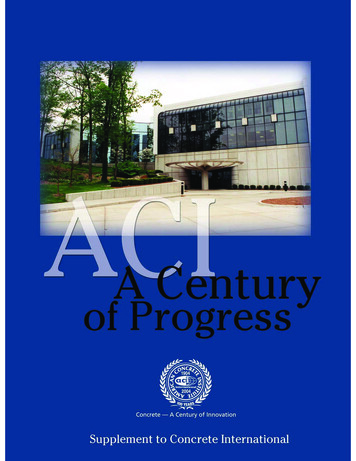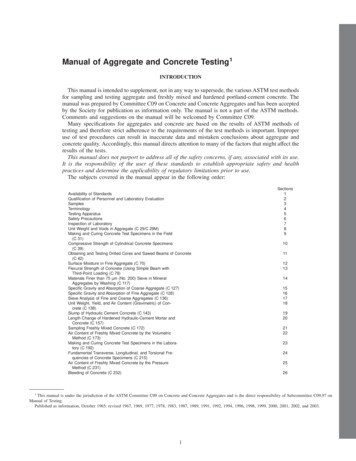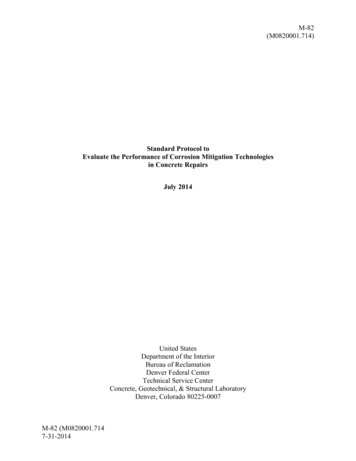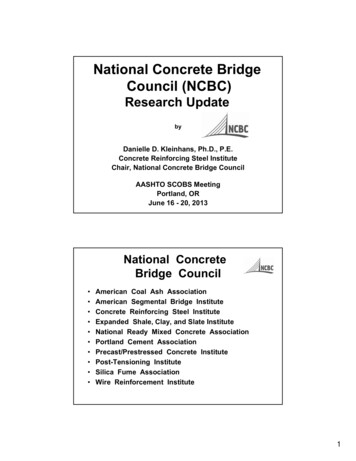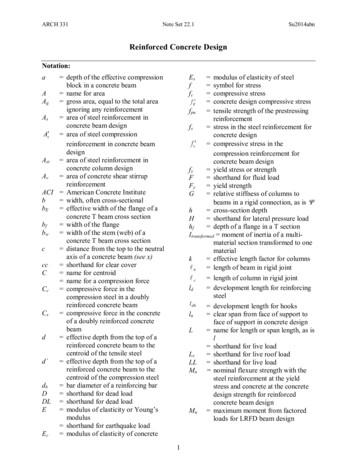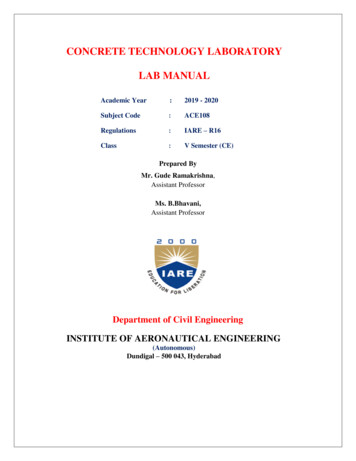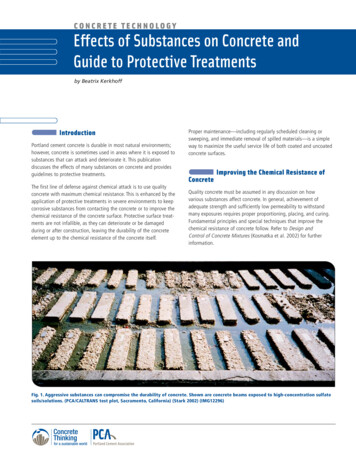
Transcription
CONCRETE TECHNOLOGYEffects of Substances on Concrete andGuide to Protective Treatmentsby Beatrix KerkhoffIntroductionPortland cement concrete is durable in most natural environments;however, concrete is sometimes used in areas where it is exposed tosubstances that can attack and deteriorate it. This publicationdiscusses the effects of many substances on concrete and providesguidelines to protective treatments.The first line of defense against chemical attack is to use qualityconcrete with maximum chemical resistance. This is enhanced by theapplication of protective treatments in severe environments to keepcorrosive substances from contacting the concrete or to improve thechemical resistance of the concrete surface. Protective surface treatments are not infallible, as they can deteriorate or be damagedduring or after construction, leaving the durability of the concreteelement up to the chemical resistance of the concrete itself.Proper maintenance—including regularly scheduled cleaning orsweeping, and immediate removal of spilled materials—is a simpleway to maximize the useful service life of both coated and uncoatedconcrete surfaces.Improving the Chemical Resistance ofConcreteQuality concrete must be assumed in any discussion on howvarious substances affect concrete. In general, achievement ofadequate strength and sufficiently low permeability to withstandmany exposures requires proper proportioning, placing, and curing.Fundamental principles and special techniques that improve thechemical resistance of concrete follow. Refer to Design andControl of Concrete Mixtures (Kosmatka et al. 2002) for furtherinformation.Fig. 1. Aggressive substances can compromise the durability of concrete. Shown are concrete beams exposed to high-concentration sulfatesoils/solutions. (PCA/CALTRANS test plot, Sacramento, California) (Stark 2002) (IMG12296)
Low water-cement ratio (w/c)—the water-cement ratio or thewater-cementitious materials ratio (where applicable) should notexceed 0.45 by weight (0.40 for corrosion protection of embeddedmetal in reinforced concrete). Water-cement ratios for severechemical exposures often range from 0.25 to 0.40 to maximizechemical resistance.Chemical admixtures (optional)—dosage varies to achievedesired reduction in permeability and to improve chemical resistance.Water reducers (ASTM C494) and superplasticizers (ASTM C1017)can be used to reduce the water-cement ratio, resulting in reducedpermeability and less absorption of corrosive chemicals. Polymeradmixtures, such as styrene-butadiene latex, used in the productionof polymer-modified concrete, greatly reduce the permeability ofconcrete to many corrosive chemicals. A typical dosage of latexadmixture would be about 15% latex solids by weight of cement.Certain integral water-repelling admixtures, also called hydrophobicpore-blocking or dampproofing admixtures, can slightly improve thechemical resistance of concrete to certain chemicals such as formicacid (Aldred 1988). However, many integral water-repellents offerlittle to no improvement; therefore tests should be performed todetermine the effectiveness of particular admixtures. (See “Evaluatingthe Effectiveness of Concrete Surface Protection by Testing.”)Admixtures containing chloride should not be used for reinforcedconcrete. Corrosion inhibitors (ASTM C1582) reduce chloride-inducedsteel corrosion. (See “Corrosion of Reinforcement” under “DesignConsiderations.”) Alkali-silica reactivity inhibitors, such as lithiumnitrate, can be considered when potentially reactive aggregate isused and when alkali solutions will be in contact with concrete.Shrinkage reducing admixtures can reduce the formation of shrinkagecracks through which aggressive chemicals can penetrate theconcrete.Cement content—at least 335 kg/m3 (564 lb/yd3) of cementitiousmaterial should be used for concrete exposed to severe freeze-thaw,deicer, and sulfate environments.Suitable cement type—cement should be suited to the exposure,such as sulfate-resistant cement to help prevent sulfate attack(Table 1). Sulfate-resistant cements, however, like other portland orblended hydraulic cements, are not resistant to most acids or otherhighly corrosive substances.Suitable aggregate—quality aggregate is not prone to freezethaw deterioration or chemical attack. If an aggregate is shown byfield performance (history) or by testing to be susceptible to alkaliaggregate reaction (AAR), appropriate measures should be taken todesign a concrete mixture to minimize its susceptibility to AAR. (SeeFarny and Kerkhoff 2007 and PCA 2007 for further guidance.) Someaggregates may be more suitable than others for certain chemicalexposures. (See “Acids” under “Design Considerations.”)Suitable water—mixing water should not contain impurities thatcan impair basic concrete properties or reduce chemical resistance.Steinour (1960), and Abrams (1920 and 1924) discuss the effects ofimpure mixing water.Supplementary cementitious materials (optional)—dosagevaries to improve chemical resistance. Supplementary cementitiousmaterials (SCMs) such as fly ash and metakaolin (ASTM C618), slagTable 1. Requirements for Concrete Exposed to Sulfate-Containing Soils and SolutionsCement type*Maximum watercementitious materialratio, by massSulfate exposureSulfate (SO4) insoil, % by massSulfate (SO4) inwater, ppmNegligibleLess than 0.10Less than 150Moderate**0.10 to 0.20150 to 1500IIIP(MS),IS( 70)(MS)MS0.50Severe0.20 to 2.001500 to 10,000VIP(HS)IS( 70)(HS)HS0.45Very severeOver 2.00Over 10,000VIP(HS)IS( 70)(HS)HS0.40ASTM C150ASTM C595ASTM C1157No special type required—* Pozzolans and slag that have been determined by testing according to ASTM C1012 or by service record to improve sulfate resistance may also be used. Maximum expansions when usingASTM C1012: Moderate exposure—0.10% at 6 months; Severe exposure—0.05% at 6 months or 0.10% at 12 months; Very Severe exposure—0.10% at 18 months. Sulfate resistance ofindividual pozzolans or slags needs to be established by demonstrating a maximum expansion of 0.10% at 1 year, before a 6 months test duration is acceptable. Refer to ACI 201 (2001) formore guidance.** Includes seawater.Test method: ASTM C1580, Standard Test Method for Water-Soluble Sulfate in Soil.Source: Adapted from Bureau of Reclamation 1981, ACI 201, and ACI 318.2
Effects of Substances on Concrete and Guide to Protective Treatments(ASTM C989), and especially silica fume (ASTM C1240) can improvechemical resistance by reducing the permeability of the concrete andby producing additional cementitious compounds. Dosages by mass ofcementitious material often range from 15% to 25% for Class F flyash, 15% to 40% for Class C fly ash, 35% to 50% or more for slag,and 5% to 10% for silica fume. Dosage is usually proportional toseverity of exposure to chemical. Supplementary cementitious materials may not prevent chemical attack but they can slow it down,significantly in some cases. Supplementary cementitious materialscan help control alkali-silica reactivity for concretes exposed to highalkali, high-pH solutions. Unless previous data exist to confirm thebeneficial effect of these materials in specific exposures, testingshould be performed to substantiate improved chemical resistance.(See “Evaluating the Effectiveness of Concrete Surface Protection byTesting.”)Consolidation—concrete should be properly molded into formsand around reinforcement to eliminate stone pockets, honeycomb,and entrapped air.Finishing—slabs should not be finished while bleedwater is on thesurface or, as this will increase the permeability at the surface,decreasing its chemical resistance (and strength). Supplementarycementitious materials or blended cements may affect the bleedingcharacteristics of concrete. For instance, silica fume mixes tend tobleed very little, and slag or fly ash mixes may bleed longer due toa slower set. Placing concrete at the proper temperature promotesuniform bleeding and setting characteristics and helps controlfinishing operations.Proper jointing—isolation, contraction, and construction jointsshould be used to control cracking. Contraction joints in slabs onground should be spaced about 24 to 30 times the slab thicknessand 36 times the slab thickness for mixtures with low water contentand large aggregates (19 mm ( 3 4 in.) or larger). Joints should beproperly sealed with a material capable of enduring the environment.Waterstops, if used, must be properly placed. Construction methodssuch as the use of heavily reinforced slabs (Farny 2001) or posttensioned slabs are helpful in reducing the number of joints in areaswhere joints are undesirable.Air entrainment—the proper amount of entrained air is dependenton the exposure condition and on maximum aggregate size (Table 2).Air entrainment makes concrete resistant to freezing and thawingcycles. In addition it improves sulfate and salt resistance, watertightness, and workability.Table 2. Target Total Air Content for ConcreteNominal maximumaggregate size,mm (in.)9.512.5192537.5(3 8)(1 2)(3 4)(1)(11 2)Air content, 565.554.54.5Adequate curing—either additional moisture should be suppliedto the concrete during the early hardening period or the concreteshould be covered with water-retaining materials. In general, curingcompounds should not be used on surfaces that are to receiveprotective surface treatments. If a curing compound is used, it mustbe completely removed before the surface treatment is applied, or itmust be compatible with the surface treatment so as not to impairbond. Concrete should be kept moist and above 10 C (50 F) for thefirst week or until the desired strength is achieved. Longer curingperiods increase resistance to corrosive substances by increasingstrength and reducing permeability for all concrete mixtures. Concretesmade with SCMs may especially benefit from extended curing.Concrete should not be subjected to hydrostatic pressure during theinitial curing period. The resistance of air-entrained concrete tofreeze-thaw cycles and deicers is greatly enhanced by an air-dryingperiod after initial moist curing. Refer to Kosmatka, et al. 2002 formore information on concrete construction practices.* Project specifications often allow the air content of the delivered concrete tobe within -1 to 2 percentage points of the table target values.** Severe exposure is an environment in which concrete is exposed to wetfreeze-thaw condtions, deicers, or other aggressive agents. Moderate exposureis an environment in which concrete is exposed to freezing but will not becontinually moist, not be exposed to water for long periods before freezing,and not be in contact with deicers or aggressive chemicals.Adapted from Kosmatka et al. (2002) and ACI 318.Suitable workability—avoid mixes so harsh and stiff that honeycombing occurs as well as mixes so fluid that excessive water rises tothe surface. If necessary, water reducers and superplasticizers can beused to make mixes more workable (higher slump). Supplementarycementitious materials can increase or decrease the workability offresh concrete, so appropriate mix adjustments should be made.Nature of Aggressive ChemicalsThe rate of attack on concrete may be directly related to the activityof the aggressive chemical. Solutions of high concentration aregenerally more corrosive than those of low concentration—but insome cases, the reverse is true. The rate of attack may be altered bythe solubility of the reaction products of the particular concrete.A lower hydroxide ion concentration generally causes more rapidattack on the concrete surface. Also, since high temperatures usuallyaccelerate chemical attack, better protection is required than fornormal temperatures.Thorough mixing—mixing should continue until concrete isuniform, with all materials evenly distributed. Silica fume may requirea longer mixing period to become thoroughly distributed throughouta concrete mixture.3
Generally there are two ways to mitigate chemical attack, (1) choosethe right concrete composition to make it less permeable or isolate itfrom the environment by using a suitable coating, or (2) modify theenvironment to make it less aggressive to the concrete (Addis 1994).Kuenning (1966) studied the nature of aggressive chemicals, modesof attack, and reaction products for mortars exposed to acids, aluminates, ammonium salts, borates, carbonates, chlorates, chlorides,chromates, ferrocyanides, fluosilicates, magnesium salts, manganates,molybdates, nitrates, nitrites, phosphates, seawater, stannates, sulfates, alcohols, amino acids, linseed oils, esters, benzene, and sugars.Type I and Type V cements were studied at varying water-cementratios. He found that resistance of mortar to chemical attack wasincreased by longer curing time and by a decrease in water-cementratio. The Type V cement mortar was more resistant to sulfate attackthan the other mortars, but not to acidic sulfates or those whichcontained ammonium or magnesium. The zero-C3A cement mortarwas generally lower in resistance to chemical attack than Type V.ConcreteVapor barriercapillary break layerof coarse stone withlittle or no finesSubgradeWater tableFig. 2. Low water-cement ratio concrete, a layer of coarseaggregate, and a vapor barrier sheet help prevent concretedeterioration due to salt attack.Basson (1989) derives in his publication an aggressiveness indexof a water sample, obtained from the chemical analysis of the waterand adjusted by factors such as prevailing temperature, flow conditions, or wet and dry cycles of the exposed concrete Guidelines withprotective treatments are given in the final index at the end of thispublication.AcidsAcids attack concrete by dissolving both hydrated and unhydratedcement compounds as well as calcareous aggregate. Siliceousaggregates are resistant to most acids and other chemicals and aresometimes specified to improve the chemical resistance of concrete,especially with the use of chemically-resistant cement. Siliceousaggregate should be avoided when a strongly basic solution, likesodium hydroxide, is present, as it attacks siliceous aggregate. Incertain acidic solutions it may be impossible to apply an adequateprotective treatment to the concrete, and the use of a “sacrificial”calcareous aggregate should be considered, particularly in locationswhere the acidic solution is not flowing. Replacement of siliceousaggregate by limestone or dolomite having a minimum calcium oxideconcentration of 50% will aid in neutralizing the acid. The acid willattack the entire exposed surface more uniformly, reducing the rateof attack on the paste and preventing loss of aggregate particles atthe surface. The use of calcareous aggregate may also retard expansion resulting from sulfate attack caused by some acid solutions.Within reason, the paste content of the concrete should be minimized—primarily by reducing water content and using a well-gradedaggregate—to reduce the area of paste exposed to attack. Highcement contents are not necessary for acid resistance. Concretedeterioration increases as the pH of the acid decreases below about6.5 (Kong 1987 and Fattuhi 1988).SaltsMany solutions that have little or no chemical effect on concrete,such as brines and salts, may crystallize upon drying. It is especiallyimportant that concrete subject to alternate wetting and drying ofsuch solutions be impervious to them. When free water in concrete issaturated with salts, the salts crystallize in the voids near the surfaceduring drying, sometimes exerting sufficient pressure to causescaling. Sodium sulfate and sodium carbonate, sometimes present inground water, are known to cause concrete deterioration from saltcrystallization, also called physical salt attack (Haynes et al. 1996,ACI 201 2001, and Stark 2002). Physical attack by sulfate salts canbe distinguished from conventional, chemical sulfate attack, forexample, by evaluating the sulfate content of the concrete. Chemicalsulfate attack increases the sulfate content of the concrete whereasphysical salt attack most likely does not. Chemical sulfate attack canbe evidenced by significant amounts of ettringite and/or gypsum, aswell as the characteristic decalcification of the paste and crackingdue to expansion. In physical sulfate attack, damage in the form ofscaling is usually limited to the exterior surface of the concrete; theconcrete is not affected below the surface. Damage due to salt crystallization can occur with a variety of salts; they need not containsulfate ions. Concrete structures exposed to salt solutions shouldhave a low water-cement ratio (0.45 maximum) to reduce permeability. A vapor barrier system of clean drain rock and plastic sheetingunder slabs should be provided along with proper drainage awayfrom the structure (Fig. 2) (Haynes et al. 1996 and Kanare 2005).Properly cured concrete with reduced calcium hydroxide contents,such as occur when pozzolans are used, may experience a slightlyslower rate of attack from acids. This is because acid resistance islinked to the total quantity of calcium-containing phases, not just thecalcium hydroxide content (Matthews 1992). Resistance to acidattack is primarily dependent on the concrete’s permeability andwater-cement ratio.4
Effects of Substances on Concrete and Guide to Protective Treatmentsaggressive at exceedingly small concentrations if there is good flowor replacement of the solution at the concrete surface.Acid rain (often with a pH of 4 to 4.5) can slightly etch concretesurfaces, usually without affecting the performance of exposedconcrete structures. Extreme acid rain or strong acids may warrantspecial concrete designs or precautions, especially in submergedareas. The American Concrete Pressure Pipe Association (ACPPA2000) provides guidelines for granular soils with a pH below 5 andthe total acidity of the soil exeeding 25 meq/100 gm and requiresone of the following precautions to be used.Table 3 shows parameters that influence the rate and extent of acidattack and resistance.Table 3. Acid Attack and Resistance of Concrete Backfill in the pipe zone with consolidated clay material orcalcareous material; Acid resistant membrane on or around the pipe; or 8 to 10% silica fume in the mortar coating.Where soil pH is below 4, the pipe should be installed in an acidresistant membrane or in an envelope of non-aggressive consolidatedclay (ACPPA 2000). Natural waters usually have a pH of more than 7and seldom less than 6. Waters with a pH greater than 6.5 may beaggressive if they contain bicarbonates.Acid attack increases withAcid resistance increases with increase in acidconcentration decrease in permeability ofcement paste (low w/cm-ratio) continuous and fastrenewal of acidic solutionat the concrete/liquidinterface low proportions of solublecomponents in concrete higher temperatures creation of a durable protectivelayer of reaction products withlow diffusion coefficient higher pressureWater that contains bicarbonates also contains dissolved free carbondioxide (CO2) and carbonic acid (H2CO3) which can dissolve calciumcarbonate unless it is saturated. This “aggressive carbon dioxide”acts by acid reaction and can attack concrete and other portlandcement products whether or not they are carbonated. Methods arepresented in Steinour (1975) for estimating the amount of aggressivecarbon dioxide from an ordinary water analysis when the pH isbetween 4.5 and 8.6, and the temperature is between 0 C (32 F)and 65 C (145 F). The German Institute of Standardization Specification DIN 4030-2 includes criteria and a test method for assessingthe potential of damage from carbonic acid-bearing water.SulfatesProtection against sulfate solutions is usually addressed by a lowwater-cementitious materials ratio and the proper selection of aportland cement, blended cement, or cement plus pozzolan or slag(see Table 1 and Stark 1989). Fig. 3 illustrates the importance of alow water-cement ratio, regardless of cement type. Fig. 4 demonstrates the visual ratings for concrete beams exhibiting various levelsof sulfate deterioration. A high water-cement ratio concrete exposedto severe sulfate solutions will still deteriorate rapidly even if asulfate-resistant cement (like Type V) is used. The importance ofcement type is most significant with moderate water-cement ratios(0.40 to 0.50). The effect of water-cementitious materials ratio issimilar to water-cement ratio.Calcium-absorptive acidic soil can attack concrete, especially porousconcrete. Even slightly acidic (pH of 5 to 6.9) solutions that are limedeficient can attack concrete by dissolving calcium from the paste,leaving behind a deteriorated paste consisting primarily of silica gel.Langelier Saturation Index values for a water solution and calciumabsorption test data on a soil sample can be used to test for thiscondition (Hime 1986 and Steinour 1975). Negative Langelier Indexvalues indicate a lime deficiency. Hime noted one project with concrete deterioration had index values of -4.2 to -7.1 in the water, andover 90% calcium absorption in the soil (percent calcium removedfrom a lime solution by an equal weight of soil). Chemical attack bycalcium absorptive soil or water can be reduced by using (1) concretewith low permeability and limestone aggregates; (2) limestone fillaround the concrete to help prevent deterioration (Hime 1986); and(3) cement- or lime-stabilized soil, flowable fill, grouting, or othertechniques to increase the pH around the concrete.1.0Rating:1.0 no deterioration5.0 severe deteriorationVisual rating2.0ASTM Type I,13% C3 AASTM Type II,8% C3 A3.0ASTM Type V,4% C3 A4.0Steinour (1966[a]) discusses the addition of calcium carbonate toweakly and strongly acidic solutions to minimize low pH conditions.Equations are provided to determine the resultant pH and the potential ability of the solution to attack concrete. Organic acids arediscussed in Steinour (1966), who notes that organic acids can be5.00.30.40.50.60.70.8Water-cement ratioFig. 3. Average 16-year ratings of concrete beams in sulfate soilsfor three portland cements at various water-cement ratios(Stark 2002).5
used to test soil and/or water for sulfate ion content to determine theseverity of the sulfate exposure.High cement contents, more than 385 kg/m3 (650 lb/yd3), withcorresponding low water-cement ratios, are very beneficial to sulfateresistance; however, high cement and high paste contents should beavoided if sulfuric or other acid is present (Kong 1987 and Fattuhi1988). Coatings can also provide protection against sulfate attack(Fig. 5). Refer to Stark (2002) for more information on the performance of concrete in a sodium sulfate environment.1Linseed oilEpoxySilaneSilane/SiloxaneNo coating2Visual ratingFig. 4. Illustration of durability range corresponding to visualratings (left to right) of 1.1, 2.5, and 5.0, respectively. (IMG25531)Sulfates react with hydrated aluminate phases in concretes toform the expansive compound ettringite, the primary destructivecompound in sulfate attack. This is why sulfate-resistant cementshave low tricalcium aluminate contents. Sulfate can also react withcalcium hydroxide in the paste to form gypsum. The crystallization ofsodium sulfate salt due to wetting and drying also attacks concreteand appears as surface scaling (Technology Publishing Company1992); see also section on “Salts” above.3450.3Some sulfate solutions are more aggressive than others; for example,magnesium sulfate can attack calcium silicate hydrate, the primarycomponent of hydrated cement responsible for strength and otherproperties of concrete (Kosmatka 1988). Kuenning (1966) studieddifferent sulfate solutions. Silica fume (ASTM C1240), Class F flyash (ASTM C618), and slag (ASTM C989) can improve sulfate resistance. However, one study (Cohen 1988) illustrated that a highconcentration of magnesium sulfate solution damaged silica-fumecement paste much more than Type I or Type V cement paste,whereas the silica fume improved resistance to sodium sulfate solutions.0.40.50.6Water-cement.ratio0.70.8Fig. 5. Effect on sulfate resistance (8 years of very severeexposure) of coatings on concrete. See Fig. 4 for illustration ofratings. (Stark 2002)Stress CorrosionStress corrosion of concrete is a deterioration induced by mechanicalstress (load) when concrete is under chemical attack. The flexuralstrength of concrete or mortar can decrease over 50% due to loadapplied to concrete when exposed to certain corrosive chemicals, ascompared to unloaded samples in the same chemical solution. Stresscorrosion occurs only when both chemical attack and load are present simultaneously. The stress accelerates both the dissolving andexpansive types of chemical attack. Some substances, such as sodiumchloride, that do not attack unstressed concrete, can become destructive when they come in contact with stressed concrete. The amountof stress corrosion increases with the load level and generally increases with the concentration of the corrosive chemical. Substanceswith which stress corrosion has been observed include ammoniumsulfate, ammonium nitrate, sodium sulfate, sodium chloride, magnesium chloride, and magnesium sulfate (Schneider 1987). The chemicalresistance of concrete discussed in this publication is aimed atunstressed concrete. More research is needed on stress corrosionof concrete, as little information is available.Environmental conditions also have a great influence on durability.Wet/dry cycling is much more severe than continuously wet conditions for sulfate attack. Therefore, testing of concrete mixtures todetermine potential sulfate resistance should simulate the conditionsto which the structure will be exposed. The sulfate resistance ofconcrete materials can be evaluated by using a saturated mortarbar test, ASTM C1012. This test is valuable in assessing the sulfateresistance of concrete that will be continuously wet, but it does notevaluate the more aggressive wet-dry cycling environment. The testcan be modified to include wet-dry cycling or the U.S. Bureau ofReclamation’s (1992) wet-dry concrete prism test for sulfate attackcan be used. ASTM C1580 (for Soil), ASTM D516 (AASHTO T 290)(for water), or the U.S. Bureau of Reclamation method (1975) can be6
Effects of Substances on Concrete and Guide to Protective TreatmentsCorrosion of Nonferrous Metals in Contact withConcreteCorrosion of Embedded MetalsCorrosion of ReinforcementNonferrous metals are frequently used in construction in contactwith portland cement concrete. Metals such as zinc, aluminum, andlead—and alloys containing these metals—may be subject tocorrosion when embedded in, or in surface contact with, concrete.The highly basic (alkaline) nature of concrete protects embeddedsteel from corrosion. The high pH (greater than 12.5) environmentprovides a protective oxide film on the steel that is passive and noncorrosive. However, carbonation or chloride ions can destroy or penetrate this passive film. Carbonation reduces the pH and allowsoxygen access to the steel, thereby developing a potentially corrosivecondition. Carbonation is not a problem with good quality concrete.Concrete’s resistance to carbonation can be improved by the application of a proper coating. Usually, use of a material having a minimumsolids content of 60% and a minimum thickness of 200 micrometersapplied in 2 or 3 coats is adequate to resist carbonation (Wei 1990).Since the products of corrosion occupy a greater volume than themetal that has corroded, internal forces of expansion can crack andspall the surrounding concrete. Galvanic corrosion will occur ifaluminum and steel or other metals of dissimilar composition areboth embedded in concrete and in contact with each other. SeePCA (2002) for more information on dissimilar metal corrosion. Ifaluminum is to be embedded in reinforced concrete, it should beelectrically insulated by a permanent coating. Bituminous paint,alkali-resistant lacquer such as methacrylate, or zinc chromate paintcan be used. Impervious protective organic coatings such as bitumen,phenolic varnish, chlorinated rubber, or coal-tar epoxies, can also beused on the metal surfaces to prevent galvanic action when it is notpossible to separate the metals.Chloride ions aggravate or cause corrosion by (1) reducing resistivity,thereby increasing corrosion currents; (2) increasing the threshold pHrequired to protect the steel; and (3) penetrating or dispersing theoxide film and combining with iron to form soluble iron chloride thatmoves iron away from the steel to form expandable iron oxides.Once chloride ions or carbonation have destroyed or penetrated thepassive film and moisture and oxygen are present, an electric cell isformed along the steel or between steel bars and the electrochemicalprocess of corrosion and rust formation begins. Rusting is an expansive process that induces internal stress in the concrete and eventually cracks and spalls the concrete over the reinforcing steel (Fig. 6).Of course, rusting also reduces the cross-sectional area and strengthof the reinforcing steel. The rate of corrosion is controlled by the electrical resistivity, chloride-ion concentration, moisture content, andavailability of oxygen in the concrete. Conclusions concerning corrosion activity of embedded steel can be made by using the information obtained with ASTM C876, Test Method for Half-Cell Potentialsof Uncoated Reinforcing Steel in Concrete.Where it is necessary to embed lead in concrete, protection of theembedded portion with organic coatings is suggested to preventcorrosion of the lead and to prevent galvanic action with reinforcingsteel. When copper is used in conjunction with steel, it should beelectrically insulated from the steel by means of an imperviousorganic coating or by use of short lengths of polyethylene tubing slitand slipped over the copper. Copper itself is practically immune tocorrosion in chloride-free concrete except where ammonia is present.However, copper, as w
Suitable workability—avoid mixes so harsh and stiff that honey-combing occurs as well as mixes so fluid that excessive water rises to the surface. If necessary, water reducers and superplasticizers can be used to make mixes more workable (higher slump). Supplementary cementitious materials can increase or decrease the workability of





